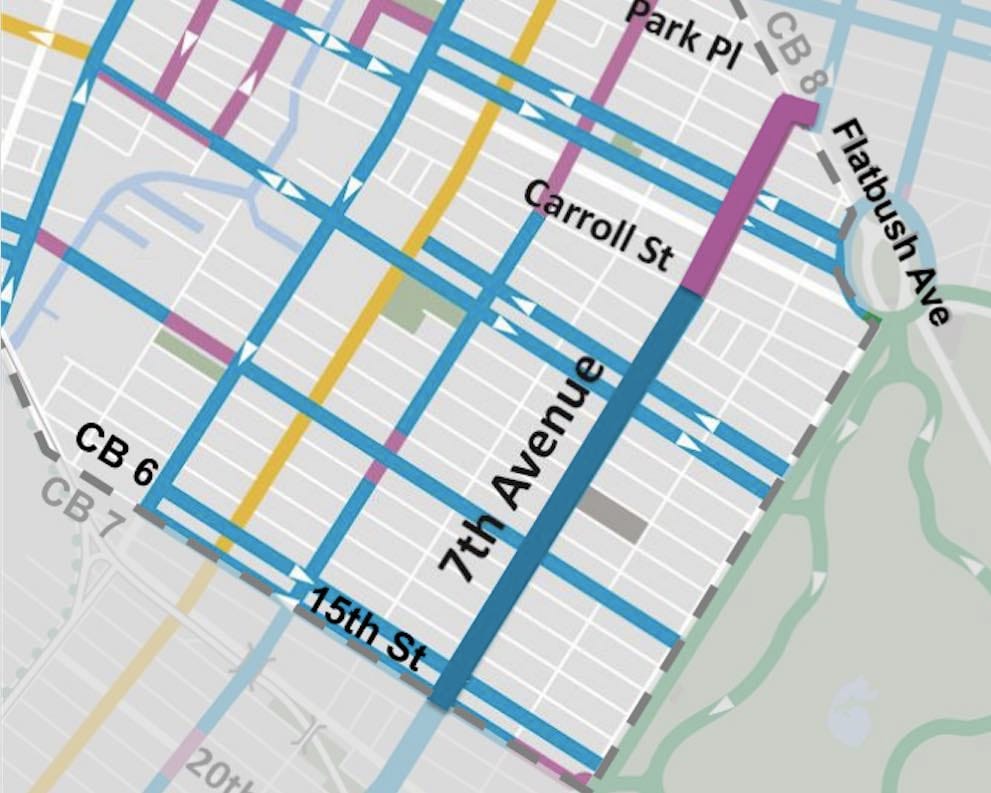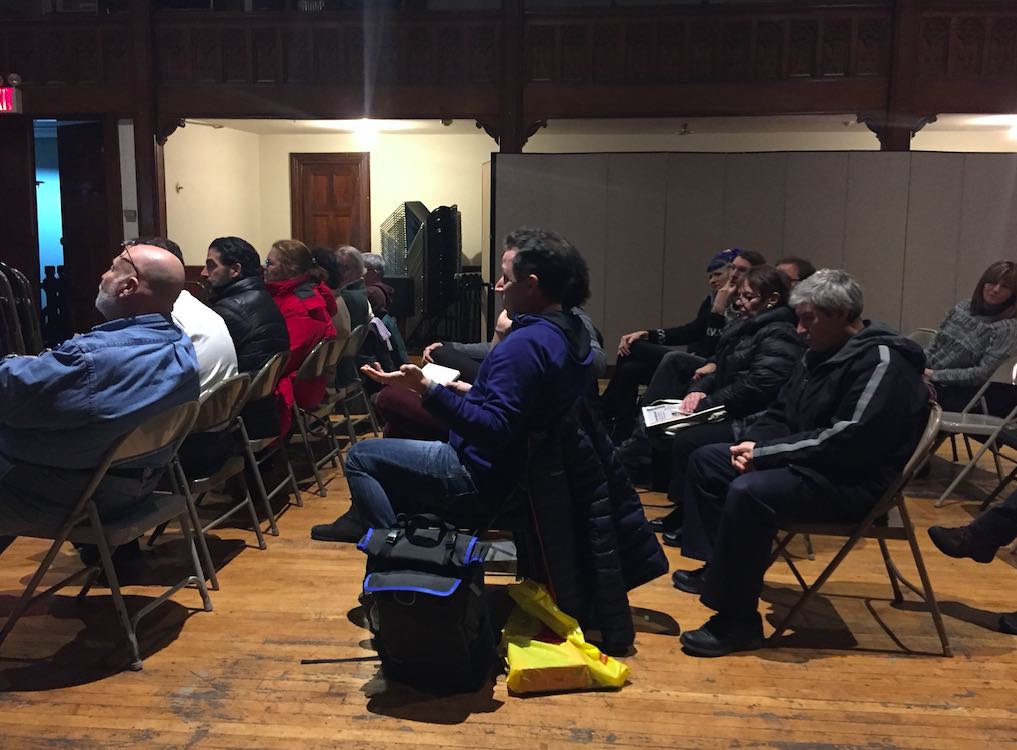Mind The Gap: Filling In The Holes Of The Bike Lane Network In Park Slope and Cobble Hill


Several locals braved the Arctic cold last night for the Community Board 6 Transportation/Public Safety Committee’s presentation and review of two new bicycle lane projects proposed for Park Slope and Cobble Hill.
In the Upper Hall of the Old First Reformed Church at 729 Carroll Street, Preston Johnson, NYC DOT Project Manager for the Bicycle and Greenways Program, presented the first proposal for a bicycle lane on 7th Avenue between Flatbush Avenue and 15th Street in Park Slope.
In an effort to fill a gap in the bike lane network in Park Slope, the proposal recommends a shared bike lane (bike routes are identified by signs only and bicyclists must share the same lane as cars) from Flatbush Avenue to Carroll Street, and a standard bike lane (a separate lane for bicyclists defined by a 5-foot-wide area painted on the pavement) from Carroll Street to 15th Street.
Currently, on 7th Avenue, the street is 50-feet wide with cars traveling in both directions and parking lanes on each side, “but [there is] no dedicated place on the street for cyclists,” Johnson noted. “So we intend to fix that situation by creating 5-foot bike lanes and 8-foot parking lanes.” The plan also includes 10-foot travel lanes for cars on both sides and a four-foot-wide center median in the road between these moving lanes that would allow cars to pass double-parked vehicles, trucks, buses, etc. safely.

However, since “the street is narrower north of Carroll Street,” on 7th Avenue, the DOT is “proposing a [12-foot] shared lane,” in this area which won’t “provide that 5-foot open space on the street, but it [will] indicate the safe place on the street for cyclists to ride” using signs. Johnson emphasized that the plan would not impact parking or “[remove] any capacity for the motor vehicles.”
Opening up the discussion to the floor, residents expressed concerns saying the plan would add to the existing traffic congestion, especially in the Methodist Hospital area; would make it unsafe for pedestrians; and would give bicyclists a false sense of security (because they’d risk getting hit by vehicles exiting parking spaces or car doors swinging open, etc.).
A couple of senior members in the audience also expressed their anger toward bicyclists who “do not adhere to traffic rules at all,” making it difficult and scary for them to cross the street. They argued that bicyclists often do not wear helmets, do not stop at traffic lights or yield to pedestrians.
Ted Wright, NYC DOT Director of the Bicycle and Greenways Program, attempted to reassure the skeptical, “We’re not changing the parking regulations. We’re not changing the number of moving lanes. We’re responding to existing cyclists that are out there on the street right now. What we’re doing is organizing the street, creating places so people know where they’re supposed to be, where they expect to see a cyclist.”
“We’re making it safer for cyclists without cutting off circulation for vehicles,” Johnson added.

One supporter of the proposal pointed out that the plan is similar to the bike lane currently on Fifth Avenue which he says works just fine. He insisted that even when cars are double-parked on 5th Avenue, he is able to get around on his bike without trouble.
Another supporter of the project was happy with this step in the right direction, however, questioned why Park Slope does not have a protected bike lane (a lane that is situated beside the sidewalk with cars parked between bicyclists and moving traffic).
Wright responded saying, “You would really have to remove a lot of parking or do a one-way conversion…. The issue is, something would have to go—we’d have to get rid of parking or a lane of traffic,” a solution that elicited a lot of groans and negative responses from the audience.
The committee approved the proposal for the 7th Avenue bike lane under the condition that the DOT returns in a year and provides statistics on the new lane including safety for pedestrians and bicyclists, changes to travel time, the number of vehicles using the route, and the number of accidents (if any). The committee also requested that the DOT look into the possibility of reducing the 4-foot center median to allow for more space in the travel lanes.
The second proposal also involved filling a gap in the bike lane network—this time on Amity and Court Streets in Cobble Hill (Community Board 2). The project would make it easier for people bicycling from the west, like Brooklyn Bridge Park or the Brooklyn Waterfront Greenway, to travel east and connect to the bike lane on Dean Street.

The DOT proposed putting a bike lane on Amity Street from Henry to Court Streets that would allow access to Dean Street. The plan would also add a new pedestrian crosswalk on the north side of Dean Street.
Johnson explained that the plan would narrow the travel lane [to 11-feet] on Amity Street to provide a “traffic calming effect,” and dedicate 5-feet for a standard bike lane with no impact on parking [parking lanes would be 9-feet wide].
The tricky part of this plan is that the streets are off-set—bicyclists on Amity Street would need to turn north on Court Street to get to the bike lane on Dean, but traffic on Court travels south. Johnson said they would resolve this with “markings and signs” while the new crosswalk on the north side of Dean Street would increase pedestrian mobility.
The issue of signage came up, with the need to create and install signs “that make it clear to cyclists that they are able to make [this] maneuver” but that cars are prohibited. Safety concerns for pedestrians using the new crosswalk were also raised, so the motion for this proposal was tabled until January.
The CB6 Transportation/Public Safety board members requested the DOT return and further address these concerns next month and hope that members of CB2 will attend that meeting as well.
You can view the full proposal here.



